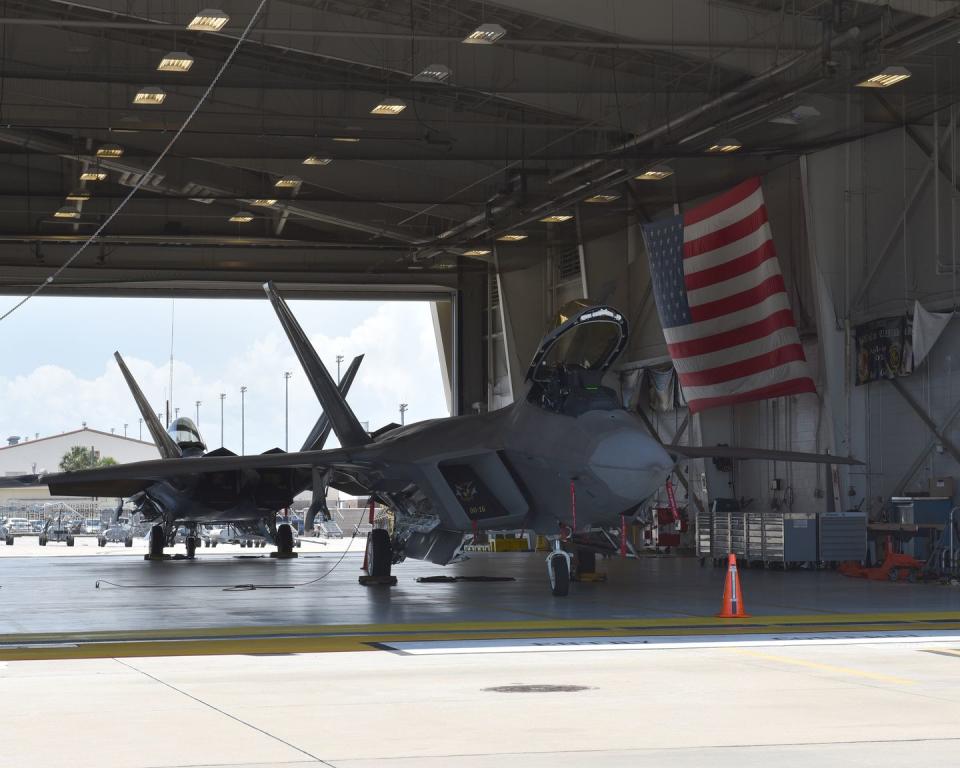Hurricane Michael Mangled at Least 17 F-22 Raptors That Failed to Flee Their Base
The U.S. Air Force is assessing what damage more than a dozen F-22 Raptor fighters suffered when Tyndall Air Force Base sustained a direct hit from Hurricane Michael. Up to $2 billion in fighter jets were trapped on the ground because of maintenance issues and forced to ride out the Category 4 hurricane. Photographs show the hangars where F-22s were parked suffered severe damage.
First, the good news: Although Tyndall Air Force Base took a hard hit from the hurricane, all 3,600 military personnel and their families living on the base were successfully evacuated beforehand. The 93 Air Force personnel who stayed behind to keep an eye on the base are all safe and accounted for.
On the other hand: Up to 17 of Tyndall’s F-22s might have sustained damage or been destroyed during the storm. The aircraft, each of which cost $150 million, were unable to escape with the rest of the base’s F-22 fleet to Wright Patterson Air Force Base, Ohio. The jets left behind were parked inside hangars and officials hoped for the best.

Post-hurricane photos showed extensive damage to the hangars, with at least one F-22 Raptor visible inside. Another photo showed a QF-16 target drone (a F-16 modified to act as an unmanned practice target) with the aircraft nose cone broken off.
The U.S. Air Force operates 186 F-22 Raptor fighters, of which only 123 are “combat coded”-that is, they have the full suite of hardware and software to make them fully operational combat-ready fighters. The rest of the F-22 fleet lacks the full range of combat capability and is largely relegated to training duties.
Tyndall is home to the 325th Fighter Wing which operates 55 F-22s split between the 43rd and 95th Fighter Squadrons. As The Diplomat explains, “The 95th Fighter Squadron’s 24 F-22s are combat-coded and operational. The 43rd Fighter Squadron’s 31 F-22s comprise the primary training unit for the Raptor.”
The Air Force has yet to reveal exactly how many F-22s were left behind, how many of those were damaged, and the extent of the damage. We also don’t know how many of the damaged jets, if any, were combat-coded models.
UPDATE: an Air Force official tells me USAF assessed the damage at Tyndall today, including F-22s that weathered the storm. All aircraft are intact and initial indications are “promising.”
- Lara Seligman (@laraseligman) October 15, 2018
Initial estimates of the damage were troubling, but Foreign Policy’s Lara Seligman later tweeted that “all aircraft are intact and initial indications are ‘promising’.” It’s worth noting that the F-22 Raptor is built tough, designed to fly twice as fast as the speed of sound and in all weather conditions. That said, falling or wind-whipped debris from the hangar structure is another matter entirely. Hurricane-force winds might also pick up a fighter jet, which is built to be lifted into the air, after all, and plunk it down hard.
Why were the jets unable to fly clear of the hurricane’s path? They were simply down for maintenance and could not be readied in time. The Air Force had just a few days’ warning, making disassembling them and flying or trucking the parts to safety impractical.
- steven wilson (@swilson88) October 12, 2018
In 2017, the Air Force’s F-22 fleet had the lowest readiness rate of all Air Force combat aircraft, with just 49 percent of aircraft flyable. Even if the Raptors at Tyndall had a 90 percent readiness rate, a very good number in peacetime, that means five aircraft from a fleet of 55 would have been left behind on the ground.
If the number of planes left behind is correct at 17, then that means the service was able to get more than two-thirds of the base’s jets into the air, a challenge especially when one considers the maintainers that struggled to get them flyable had to be evacuated themselves. While we don’t know the extent of the damage to the jets, it’s pretty safe to say that if the readiness rate for the F-22 was higher we’d be worrying about the fate of fewer planes.
According to Combat Aircraftthe base was decimated. “The flight line is devastated. Every building has severe damage. Many buildings are a complete loss.” Bu why was an Air Force base in the heart of America’s hurricane country so badly prepared for a big storm, especially protecting billions of dollars’ worth of fighter jets? Could the Air Force not foresee the possibility of having to evacuate the base and being forced to protect grounded jets from a hurricane?
The Air Force continues to survey damage at Tyndall, with Air Force Secretary Heather Wilson, Air Force Chief of Staff David Goldfein, and Chief Master Sgt. of the Air Force Kaleth Wright visiting the base on Sunday. Air Force RED HORSE engineering units, trained to re-open damaged air bases in wartime, are on the ground cleaning up hurricane debris while Air Force special operations forces reopened the airfield so supplies could be flown in.
('You Might Also Like',)

